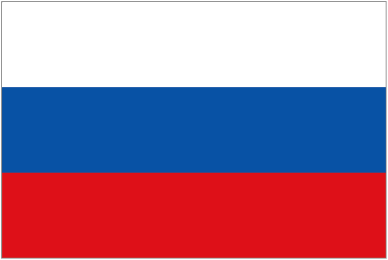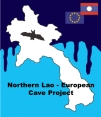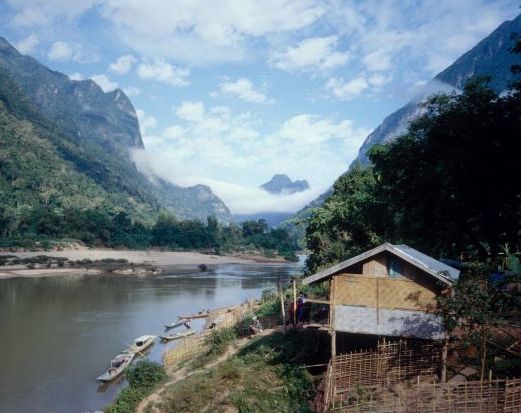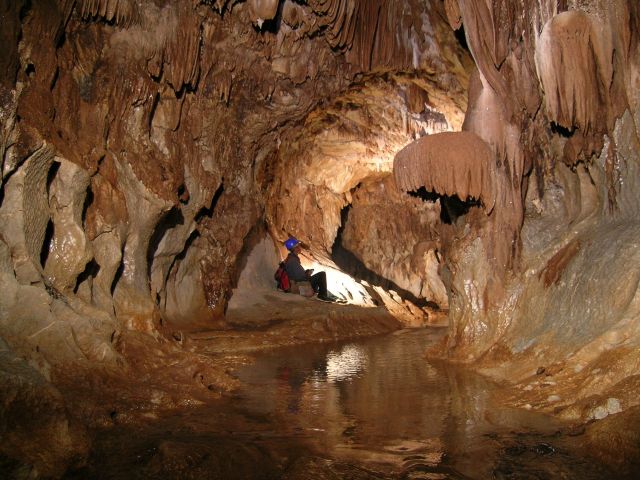| Laos 2013 Expedition
Expedition Laos: 30. December 2012 - 21. January 2013
Reece Myanmar: 10. January - 19. January 2013 |
 EuroSpeleo FSE EuroSpeleo FSE
|

NSS Exploration |
|
Houaphan Team: |
 Michael Laumanns (coordinator), Carsten Ebenau
Michael Laumanns (coordinator), Carsten Ebenau
 Yulia Chistyakova, Irina Ermakova
Yulia Chistyakova, Irina Ermakova
 Terry Bolger, Matt Oliphant,
Nancy Pistole
Terry Bolger, Matt Oliphant,
Nancy Pistole
|
Nong Khiaw and Myanmar Team:
|
 Joerg Dreybrodt
(coordinator),
Helmut Steiner
Joerg Dreybrodt
(coordinator),
Helmut Steiner
 Matt Oliphant*,
Matt Oliphant*,
Nancy Pistole*, Angela Morgan*
 Urs Etter
Urs Etter
 Eskil
Sørensen
*
Eskil
Sørensen
*
* only Laos |
The two expedition teams returned with in total 13.5 km of surveyed
cave passage in Laos and 2.5 km in Myanmar.
The Houaphan team continued in a new area north of Xam Neua which was
only briefly visited on the last day of the 2012 expedition. The area
proved to have a high potential with a number river caves exceeding 1 km
in length, the longest being Tham Nam Oogh at 3 km. Several caves still
continue, e.g. Tham Houay Ngot, another underground stream left in open
passage where the team mapped 1,850 m of passage. The river flowing
through this cave is suspected to connect to Tham Giga, which was a
record-breaking discovery of the Houaphan team representing the largest
cave passage found so far in Northern Laos: although only 350 m long,
the main gallery of Tham Giga partly measures 90 m in width and 50 m in
height. Other connections of caves north of Xam Neua appears to be
likely. A brief reconnaissance trip to other villages in the area
confirmed the existence of more underground rivers and large fossil
caves. Access to the caves north of Xam Neua partially requires long
hikes with luggage. The constantly cold and foggy weather during the dry
season also contributes to make it a challenging area for caving in
Northern Laos. In total, about 8.8 km of cave passages were mapped north
of Xam Neua. The team spent its final week in the well-known area of Viengxai east of
Xam Neua, where access to new caves has been improved by new
infrastructure. Several new caves and historical man-made caverns were
added to the long list of caves in this beautiful tower karst. This
includes Tham Fam, a fine underground stream about 1.1 km long. About
3.2 km of new cave passages were harvested around Viengxai and the area
was again left with a good number of more caves noted but left for a
future visit.
The objective of the Nong Khiaw team was to revisit and to continue the
survey of the Tham Doun Mai which was surveyed to a length of 2,000 m
beyond a large chamber of 100 m length and 50-60 m height and was left
in wide open passage in 2012. The 2013 expedition surveyed another 1.7
km until the terminal sump was reached. The cave has a very diverse
character including a fossil upper level with beautiful formations, a
sportive section at the river level dominated by water and cascades,
followed by classical big river passages with a meandering stream and
ending in an upward-trending passage with challenging climbs in active
waterfalls. With 3.7 km of length Tham Doun Mai is currently the 4th
longest cave in Northern Laos.
The recce to Myanmar targeted the Pinlaung river valley in Southern Shan
State. Here the Namun spring cave which is the resurgence of a larger
karst area was first described by Dunkley in 1989 and the entrance
confirmed in 2005 by La Venta. The team got access to the restricted
area and surveyed 1.2 km of passage. It is an system determined by large
overflow passages with an underlying stream. The water volumes in rainy
season are estimated large and in an order of 100 cm/s.The sink
of Te Toke Taung is about 5 km in distance and still undescended. Other
caves in the same area were surveyed as well and revisit to the Hopong
area done. In total 2.5 km were mapped.
Follow-up in the areas of Laos and Myanmar will be discussed while the team is meeting
during the International Caving Conference in Brno July 2013.
|







